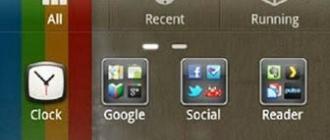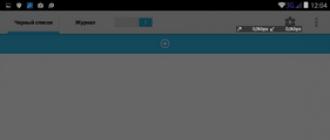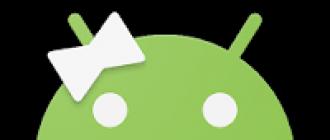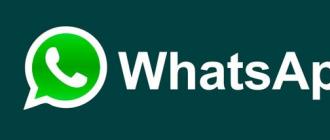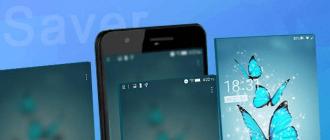External hard drives are becoming more and more popular with PC users every day. The thing is that very often there is a catastrophic lack of space on the built-in storage device, and in order not to change the medium, you can use the HDD (external hard drive). The modern model of such a device is a small box that can hold 1-2 TB of information. But what if the computer does not see the external hard drive, moreover, immediately after buying a new device. Today we will try to understand the situation and tell you what to do if the computer does not see the removable hard drive, depending on the cause of the malfunction.
The computer cannot see the external hard drive. The reasons
Before solving the problem, you need to understand the cause of the problem. Let's consider the main ones.
Malnutrition
If the hard drive is large enough, then its absence in the "File Manager" may be caused by insufficient power supply. This situation occurs if you are using a USB hub with other devices already connected. All USB interfaces, depending on the type, deliver different power.
Important! Try plugging the connecting cable into different USB jacks. One of the connectors may be able to provide sufficient power to operate the device. Or plug the media directly into the port.
Broken connection cable
Replacing the cable will help fix the situation.
The hard drive model has a different connection, not USB
There are a huge number of devices on the market today that have different parameters and connections. Some devices require a separate cable for power connections. All these nuances must be checked during the purchase according to the technical description.
Important! Perhaps you connected the device as usual - via USB, but it was necessary to use an additional power cable.
Settings problem
If the computer does not see the external hard drive, the reasons may also be the following:
- Driver problem. If the operating system cannot correctly identify the drivers for the external drive, then you should download them from the official website. If you have a new media, then the drivers must be written on it.
Important! Extract them on another computer that has managed to recognize the device.
- The BIOS does not include USB support. If the other computer recognizes the external drive, then check if USB support is enabled on your PC.
- Device malfunction. If manipulations with the USB connection do not work, then check the device's performance by connecting it to another computer, the drive may be faulty. In case of mechanical damage, contact the service center.
Important! For these problems to be prevented and resolved:
- Choose the cord for connecting the device as short in length and as thick as possible. All of this significantly affects the transmission of power.
- The problem with the lack of power can be solved in this way: connect the cable with two connectors at one end to different slots on the case of the system unit. Thus, the device will receive electricity from two sources.
What to do if the problem is in the settings
The removable media must have a name in the management interface for the computer to identify the device. But sometimes it happens that the disk is not detected due to an incorrect configuration in the BIOS. You can fix the situation by going into the settings and changing the configuration to another one suggested from the list. After these manipulations, restart your computer.
Detailed instructions:
- Click the Start Menu.
- Click “Computer Control Panel”.
- Make sure you are browsing items by category (in the upper right corner it says “View”).
- Click on “System and Security”.
- Find the "Administration" item.
- In the window that opens, find an item called "Computer Management".
- In the left window that opens, select "Disk Management". You should be able to see all drives connected to the system, including external ones. Your task is to change the drive letter of the removable drive to the one that is not in the operating system.
- Find your external information source in the window, then right-click on it and select “Change Drive Letter or Drive Path”.
- In the window that opens, select "Change".
- Choose any letter you like.
- Click “OK”.
Important! If this is your first time connecting a new drive to your computer, it is most likely not formatted and therefore will not appear in the My Computer window. In this case, you cannot change the letter. Right-click the external drive and select Create Simple Volume, but remember that this process will erase all data on the storage medium.
Application problems
Problems with the fact that the computer does not see the external hard drive often arise after working with programs such as Acronis and Alcohol, and other similar applications for creating virtual storage devices. In the process of working with such programs, the PC switches to communication with virtual disks, and real ones ceases to see.
In this situation, you need to return the system to its previous state or completely uninstall the program along with all the settings.
Important! Check if there are any previously created virtual disks left on the system. If present, remove them and restart your computer, resetting CMOS settings to default settings.

We solve the problem with the drivers
If the external drive is new, and it is not in the “My Computer” window, then 99% of this phenomenon is related to the drivers. Proceed as follows:
- From the control panel go to the “Device Manager” tab. Make sure you browse the menu by small icons (top right corner).
- Expand the Disk Devices tab.
- Notice if there is an exclamation mark in a yellow triangle next to the drive. If the triangle is present, then update the driver.
Important! If you didn’t find your drive, try to find it in “Other devices”.
- Remove the old driver by right-clicking on the device and select the “Uninstall” task.
- Unplug the device and plug it back in a minute later into the USB port. The driver should be automatically detected and installed.
Important! Typically, the operating system Windows 7 and 8, when connecting any new device, automatically installs a driver for it. If this does not happen, then click in the device manager command "Actions" -\u003e "Update hardware configuration" or download the driver from the official website of the manufacturer of the HDD device.
If you can't see your old external hard drive
If the external media previously worked on your computer and then stopped, then proceed as follows:
- Check the USB through which you are connecting the drive by connecting any other device (phone, player, printer, etc.). If necessary, reinstall the USB controller driver.
- Check the cords for damage. The cable should not be damaged and the USB plugs are firmly connected to the computer and HDD. If necessary, replace the cord with a new one.
- Go to the control menu and change the drive letter as described above. Be sure to do this if you have created new partitions on your hard drive.
- Check the external HDD for viruses. Some viruses block disks and disable the ability to see them.
- Go to "Device Manager" and find out if the device is detected correctly. There should not be any yellow or red exclamation marks that signal errors.
- Check the health of the hard drive on another computer or laptop. In this case, reinstalling the operating system may help.
Usually, the suspects in this case are software failures, incorrect operating system settings, outdated drivers, malfunctions of computer USB ports, adapters or the drives themselves.
Depending on the reasons, the problem manifests itself in each case in a different way. It happens that the computer does not react at all to a USB flash drive or hard drive. In other situations, the sound of connecting a new device is heard, but the drive icon does not appear in the explorer. And sometimes the computer just freezes right after contact with the USB device.
What to do if a Windows computer does not see a USB flash drive or external hard drive
First, figure out what exactly the problem is: with a computer, an adapter (if connected via a cable) or a drive. Try connecting your USB device through different ports. If it does not help and you are using the cable, try replacing it with a spare one. If unsuccessful, check if the drive opens on other computers.
If the device works on another PC or you have no way to check it
Connect a hard drive or flash drive to your computer and follow these steps in order. If the first does not help, move on to the next and so on.
If the other PC does not see the drive either, or all of the above tips did not help
In this case, the problem is most likely in the drive itself.
If you have a flash drive, not a hard drive, you can use special utilities to fix software errors. Such software can usually be found on the manufacturer's website. For example, JetFlash Online Recovery is for Transcend drives. And USB Flash Drive Online Recovery is for ADATA flash drives. But keep in mind that during the recovery process, these utilities erase all data from the flash drives.
If none of the above helped, then it is probably a physical malfunction of the hard drive or flash drive. Then it is better to show the device to a specialist or return it to the store under warranty.
What to do if Mac does not see a USB flash drive or external hard drive
On Apple computers, the verification procedure is somewhat different, but it follows approximately the same algorithm. We will assume that you have already tried restarting your computer, disconnecting and connecting a USB flash drive, and also made sure that the connection is reliable. If this does not help, you need to do the following:
Open the built-in tool for working with disks ("Programs" → "Utilities" → "Disk Utility") and check if the problematic flash drive is displayed there. If the drive is still visible, try it by pressing the "Erase" button and reconnect it. Keep in mind that all data from the flash drive will be permanently deleted.

Dedicated Mac Diagnostic Tool provides detailed information about all software and hardware components of your computer, including USB devices. Open the Apple menu, then hold down the Option key and click System Information and navigate to the USB section in the menu that appears.

If the flash drive is there, then the problem lies in the software and you can try to restore the disk by referring to the manufacturer's recommendations. If there is no information about the flash drive, then the point is a physical malfunction, and you should contact a store or service center if the repair makes sense.
(portable hard drives) are gradually becoming no less popular than the usual flash drives (flash drives). But, like flash drives, they are not immune from various kinds of malfunctions. Sometimes it happens that the computer "does not see" the external HDD connected to it. What if the external hard drive is not detected?
The computer does not see the hard drive
First, it's worth checking if the USB ports on the computer are functional. Try plugging the drive into a different port (if you plugged it into a port on the front panel - try the ports on the back), if possible - plug it into another computer. If the drive is detected on another computer, the problem is most likely with the USB port of the computer. The case may be:
- Disabled USB support in BIOS (but then no other USB devices will be detected). You need to enable USB support.
- Driver problem. Go to Device Manager in the Control Panel, find your external hard drive there, right-click on it and select Update drivers... If it does not help, select the item Delete, restart your computer and try reconnecting the drive.
- Incorrect letter assignment. The system may have assigned the drive letter of an already connected device to the external HDD. To fix this, go to Control Panel, select Administrative Tools - Computer Management - Disk Management. Right-click on your HDD, select "Change drive letter or drive path" and assign an unoccupied letter to it.
Basically, many of the problems that arise when connecting an external hard drive are similar to those with flash drives. In our article "" you will find a description of such problems and possible solutions.
Lack of food
External hard drive won't startIf the USB ports are okay, your hard drive may not open because it lacks power. External HDDs are powered from the USB port. When connecting a disk to the front panel connector or using a USB extension cable, it happens that the power "does not reach". Therefore, you need to connect it with the standard cable supplied with the disc to the port on the back of the computer.
If the drive has two connectors for connecting to two ports at once, you need to connect both. For transmission, one is enough for him, but for power - no, he needs to receive power from two ports at once. If an optional power supply is included with the disc, use it.
Also, the problem may be with the power supply unit of your computer: it may be outdated, or there is too much hardware installed on your computer, and the power supply unit simply does not "pull" the external drive. Then you will have to install a more powerful power supply.
Hard drive malfunctions
Finally, the hard drive may not be detected due to a malfunction in itself:
- If it is does not make any sounds, then, most likely, the hard disk controller has failed. In this case, the disk will be rescued at a data recovery service center. And if not a disk, then at least the information on it or part of it.
- If, when connected, you hear muffled soundswhen the spindle is trying to spin (the spindle is the shaft on which the magnetic disks are held), then the problem may be in the displacement of the read heads, a jammed bearing or a broken spindle motor winding.
- If a couple of seconds after the spindle spinning sounds are heard sounds like tickingsignifying movement of the readheads, the problem could be a malfunction of the magnetic heads, a malfunctioning controller or one of the chips, or one of many other failures.
If the problem is with the hard drive itself, you should take it to the repair instead of trying to fix it yourself. Only a service center can accurately diagnose and fix the problem. Therefore, if you are sure that your hard disk is not detected precisely because of a breakdown (you have already managed to exclude other possible reasons), do not try to connect the disk again and again (you can break it), but immediately contact the specialists.
Laptop does not see external USB hard drive
Imagine: you are working at a computer and here you need documents from an external hard drive. You plug it in, and ... nothing happens. Your HDD is not working. Don't panic, there are several ways to extract data from it that you can try before contacting the professionals.
Failure can occur for a number of reasons, but most often for the following two. The first (and most easily fixable) problem is in the software. You may have accidentally deleted the folders you want or formatted the disk. The second - and most common - is disk damage. As a rule, in the event of a damaged disk, you can do little on your own; you will need professional help. However, here a few tricks that can save your files.
Data recovery software
The first thing to remember when recovering data is the damaged disk should be disconnected... With every second of his work with the computer, the chances of his recovery are diminishing. The operating system of the computer constantly reads and writes information to the disk, regardless of whether you are working with it or not. It will define the space freed from lost files as “unallocated” and write new data, erasing the last chances of recovery.
Turn off the computer to which the disc with the lost data is connected. Now that the HDD is relatively safe, you can make a copy of it and try to recover data from it.
There are many different programs for cloning a disk, for Linux, Clonezilla and Redo Backup Recovery are suitable.
Scan the clone with several recovery programs: TestDisk (Windows / Mac / Linux), Recuva (Windows), PhotoRec (Windows / Mac / Linux), Restoration (Windows), Undelete Plus (Windows).

The main components of the hard drive are: cover and circuit board removed.
Disassembling a hard drive
Congratulations if you were able to recover your lost data programmatically. But what if the disk is not detected, or the computer detects it, but freezes upon access? Or does it just not start, you cannot hear the characteristic rotation sounds?
Let's take a quick look at the main components of a HDD and the symptoms of a breakdown.
Printed circuit board: The green board at the bottom of the device contains the main controller (analogous to the processor in your computer) and many other electronic controllers. It is an interface that turns binary code into commands available to the computer.
Magnetic disks ("pancakes"): HDD contains from one to several thin magnetic disks. Data is stored directly on them. Made of glass or alloy, they are magnetically coated and rotate at speeds from 5900 to 7200 rpm.
Head block: Data from magnetic disks are read by a set of magnetic heads. During operation, they do not contact the disk surface, but "hover" nanometers away from it, reading and writing information. Typically, each HDD has two voices, one on each side. If the heads break after being dropped or hit by a device, they stop hovering over the disc, but come into contact with its surface, destroying data at a speed of several thousand revolutions per minute.
Firmware: Data processing is controlled by the device firmware. A firmware failure may result in the inaccessibility of data on the disk. Unfortunately, the firmware of the HDD is not the same as that used in a mobile phone or tablet - it cannot be updated or flashed.
Now, having familiarized ourselves with the main components of the HDD, let's look at breakdowns and their symptoms. Having determined where the problem occurred, you can estimate the likelihood of fixing it on your own.
Disk won't start
The case when there is a good chance to resurrect a hard drive if you are willing to put in the time and effort. If the drive does not respond at all when connected to a computer, in 99% of cases the reason is in the printed circuit board.
For older HDDs, sometimes it was possible to find a suitable board from a similar device and replace the defective one. Modern hard drives use new architecture and technology, each HDD contains a unique microcode. In this case, a simple replacement of the board will not only not solve the problem, but can also lead to a complete loss of data.
There are two reasons for this failure: due to a voltage drop, the TVS diode burned out or one of the main components of the board failed. To protect against voltage surges, the hard disk board is usually equipped with two TVS diodes: 5 and 12 volts. If the problem is only a burned out diode, replacing it will bring the device back to life. It is easy to check with a multimeter - if the resistance is near zero ohms, the diode is burned out. Remember that after removing the TVS diode, the hard drive remains unprotected from voltage surges!

PCB: marked with TVS diodes
If the multimeter shows the correct resistance, the problem is in the printed circuit board and needs to be replaced. A ROM block with a unique microcode is soldered on the board; to restore the device, it must be unsoldered and transferred to a new board. Some hard drives, such as Western Digitals, do not have a ROM block, and the firmware is contained in the main controller, which is almost impossible to replace. Also, check the connectors for the heads on the board. Sometimes they corrode over time, which can be easily removed with an eraser. 
Corrosion of the contacts can cause disk failure.
The disc starts up and clicks are heard
This serious damage to one or more of the magnetic heads can also mean damage to the magnetic disk. In this case, it is worth contacting specialists. The HDD will be opened in a clean room (without dust), the head will be replaced and the data will be restored. The clicking disc should be turned off; turning it back on may permanently damage it.

Hard disk after damage to the magnetic heads, scratching the disk.
The hard drive starts up and is detected by the computer, but freezes when trying to access.
This usually means damage to the surface of the magnetic disk. The disk tries to read bad sectors, of which there are too many, and freezes. If SMART monitoring shows a large number of reassigned sectors, the diagnosis will be confirmed. This is a common problem that can be solved by using professional disk imaging equipment.
If you want to fix this problem yourself (at the risk of worsening the situation or losing all the information at once), you can use software tools to take a disk image. The Linux application dd_rescue is best suited for this purpose. However, the effectiveness of such programs is limited, since the commands still go through the BIOS.
When turned on, the hard drive beeps
Beeping sounds mean that the motor is trying to set the disc in motion and cannot. This could be a "sticking" of the magnetic head. If the heads are not properly parked and remain above the surface of the disc after it stops, they can "stick" to the surface of the disc. To eliminate this breakdown, it is required to open the disc in a clean room, remove and replace the heads. Definitely a job for professionals.

Parked heads after stopping the disc. When they stick, they get stuck on the surface of the magnetic disk.
Another cause of beeping sounds when turning on the drive may be a spindle lock. This is the axis of rotation of the magnetic disks. The spindle can jam due to falling or impactHDD ... There are two solutions to this problem, both requiring professional intervention: replacing the spindle or swapping the magnetic disks into a new donor hard drive..
The hard disk starts up normally, but the disk space is not detected or is incorrect
This usually indicates a problem with the firmware. It is not read correctly, possibly by a faulty head, or incorrectly written for the same reason. In this case, modern HDDs require professional intervention.
To summarize, in several cases you can try to reanimate your hard drive yourself. However, remember that any such attempts are very risky and if the lost data is very important, it is worth seeking professional help.
If yesterday a well-working hard disk for no apparent reason stops working at one not very beautiful moment, it is like a disaster. Remembering the information stored on it, you suddenly begin to understand that there is nothing valuable there - all the data is priceless. Certainly someone noticed that if the computer does not see the external hard drive, then it's like the end of the world. Although not always so deplorable.
The main thing is not to succumb to provocations, but to think carefully why What exactly has changed since the last launch? The correct answers to these questions make it possible in almost half of the cases to independently restore the media's performance. Next, we will talk about the main reasons why the computer
Perhaps, in his life, every person had at least once to get into a situation when the most complex mechanism stopped working due to an inconspicuous part that was out of order. Hard drives, both external and internal, were not spared this fate. Currently, USB hard drives are popular, but there are also SATA drives, which are significantly superior to the first in terms of speed. Any external hard drive is connected to the computer through the corresponding port connector. This is one of the most commonplace reasons why a computer does not see an external hard drive. There are two types of USB connectors: some are soldered on the motherboard and are brought out from the back of the system unit, while others are built into the case with an output to the front panel. Obviously, most users connect the hard drive to the most accessible connectors, that is, on the front panel of the case. And since only a few have a computer assembled in a reliable case, it is not surprising that Chinese manufacturers have saved on connector elements. For example, sliding contacts may not be spring loaded enough, their area is reduced in order to save money, and the materials used may be too wearable. It follows from this that sometimes, connecting the hard drive's interface wire to the port, you cannot see the external hard drive. The problem is in the connector pins. There are two ways to solve it:
- connect to ports on the motherboard;
- buying a quality USB extension cable is cheaper than replacing the case.
The next reason is lack of nutrition. The USB 2 standard assumes a maximum current of 500 mA per port. Therefore, if too many USB devices are connected, then the hard drive may not have enough power to work. Solution: we remove all "unnecessary" (webcams, USB-modems, etc.) or buy a hub with a power supply. In addition, the connectors on the front panel are connected to the motherboard by harnesses of thin wires, which also have their own voltage loss. It is worth remembering that these connectors are suitable, first of all, for low-power devices (flash drives, phones).
If the hard drive still does not work, then you need to check the BIOS settings: whether USB ports are prohibited in it. For devices using a "pocket" (mobilrack), it is useful to check the status of the internal loops and connectors - perhaps this is the reason.
After that, you should check the software part of the computer. Although external hard drives are designed to work out of the box, usually without requiring any special drivers, you still need to install the chipset software package on the system. This is especially important for generations prior to Windows Vista. There may also be a conflict in the configuration of the connected devices; in such a situation, the computer often cannot fully boot at all.
Of course, internal damage to the hard drive itself is possible. It is not always possible to restore it on your own, so you need to find out where the nearest service center is.

